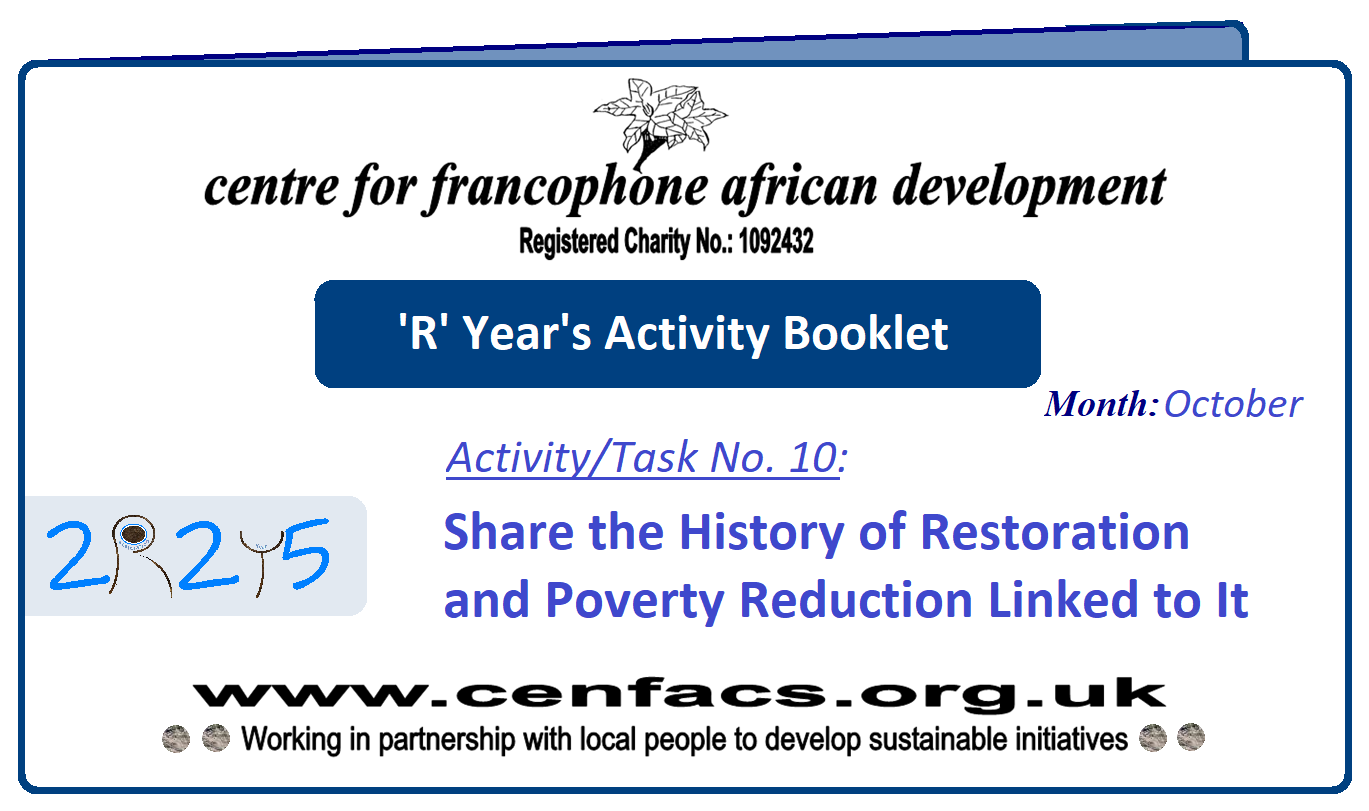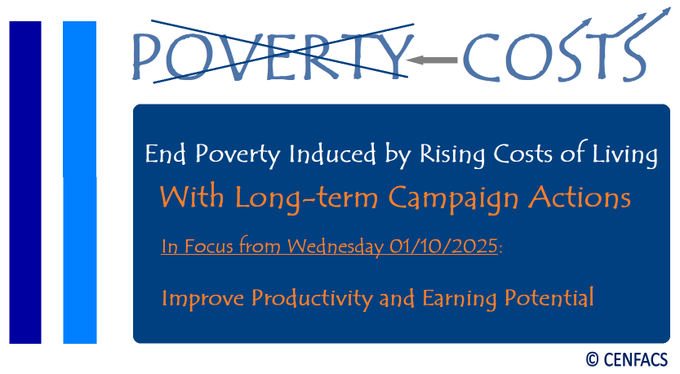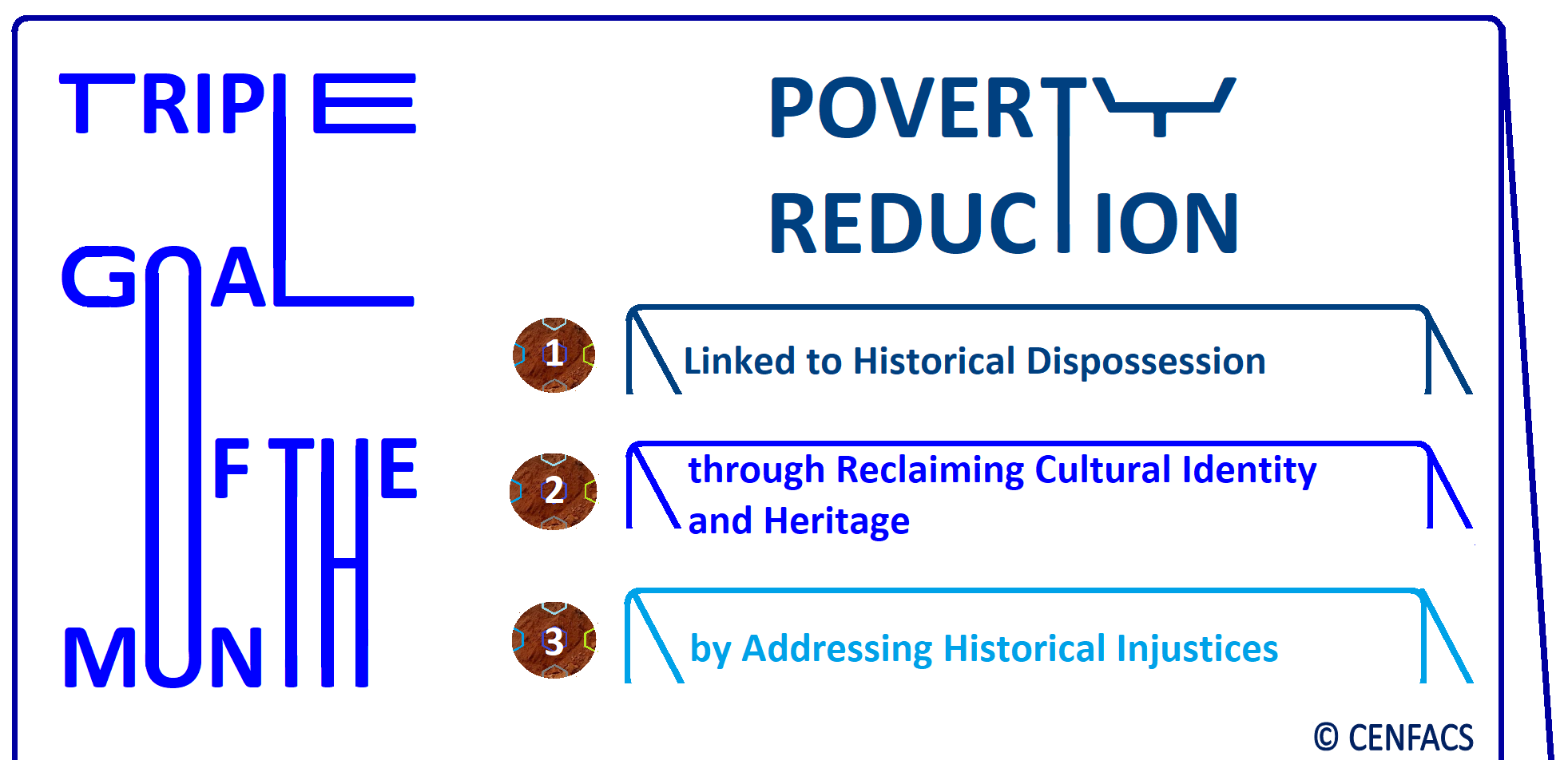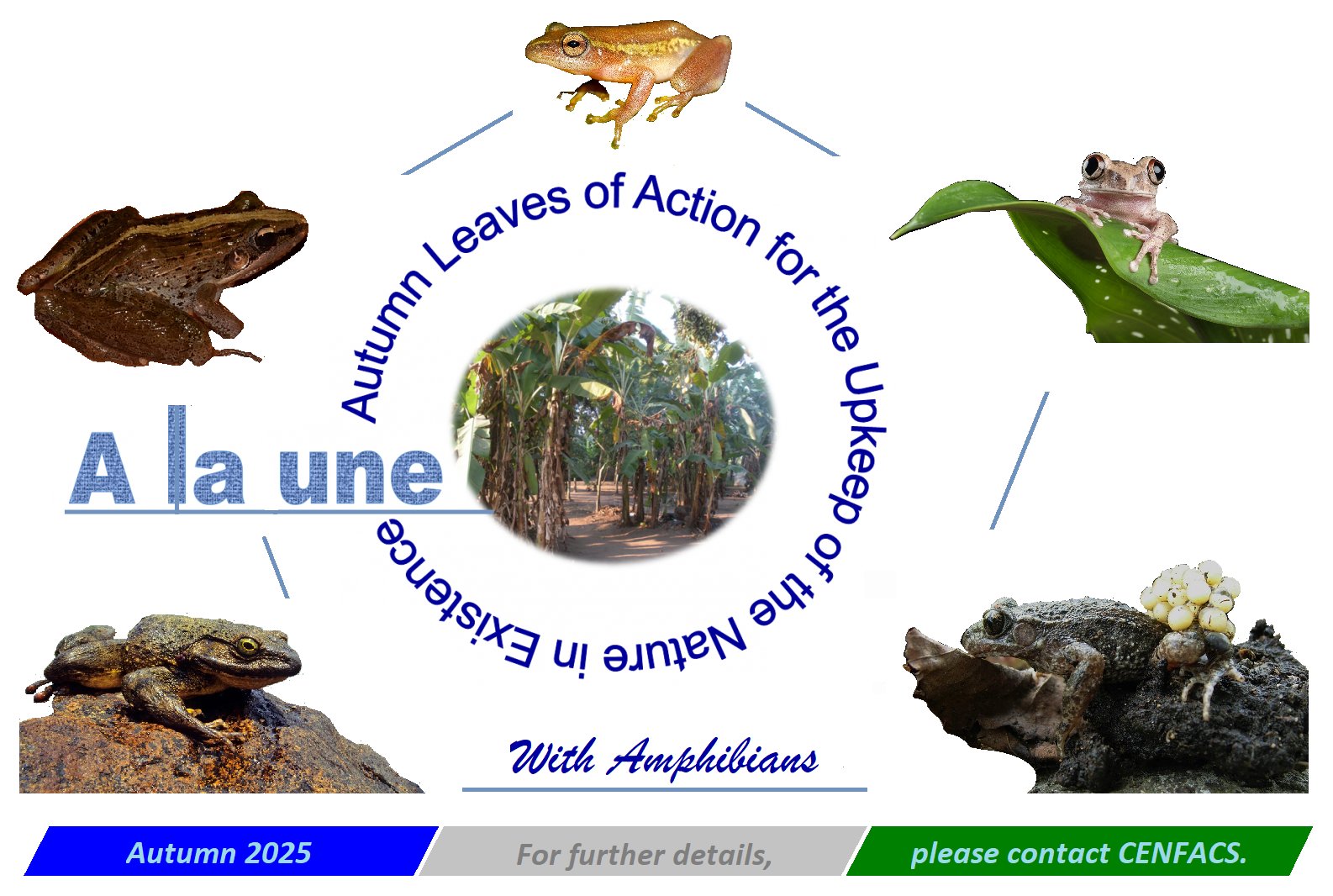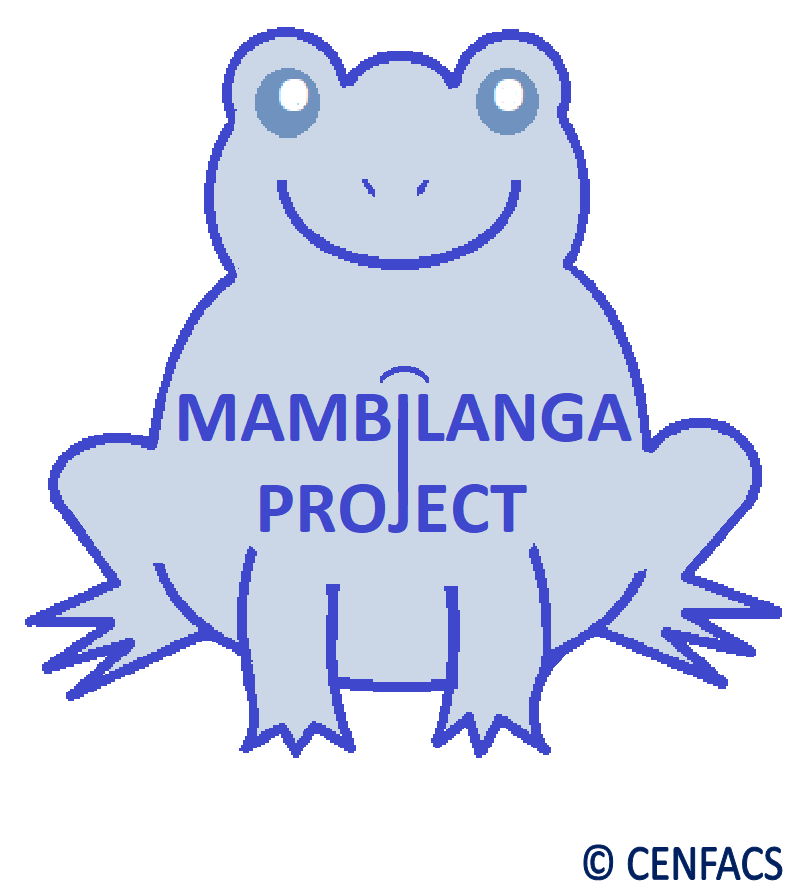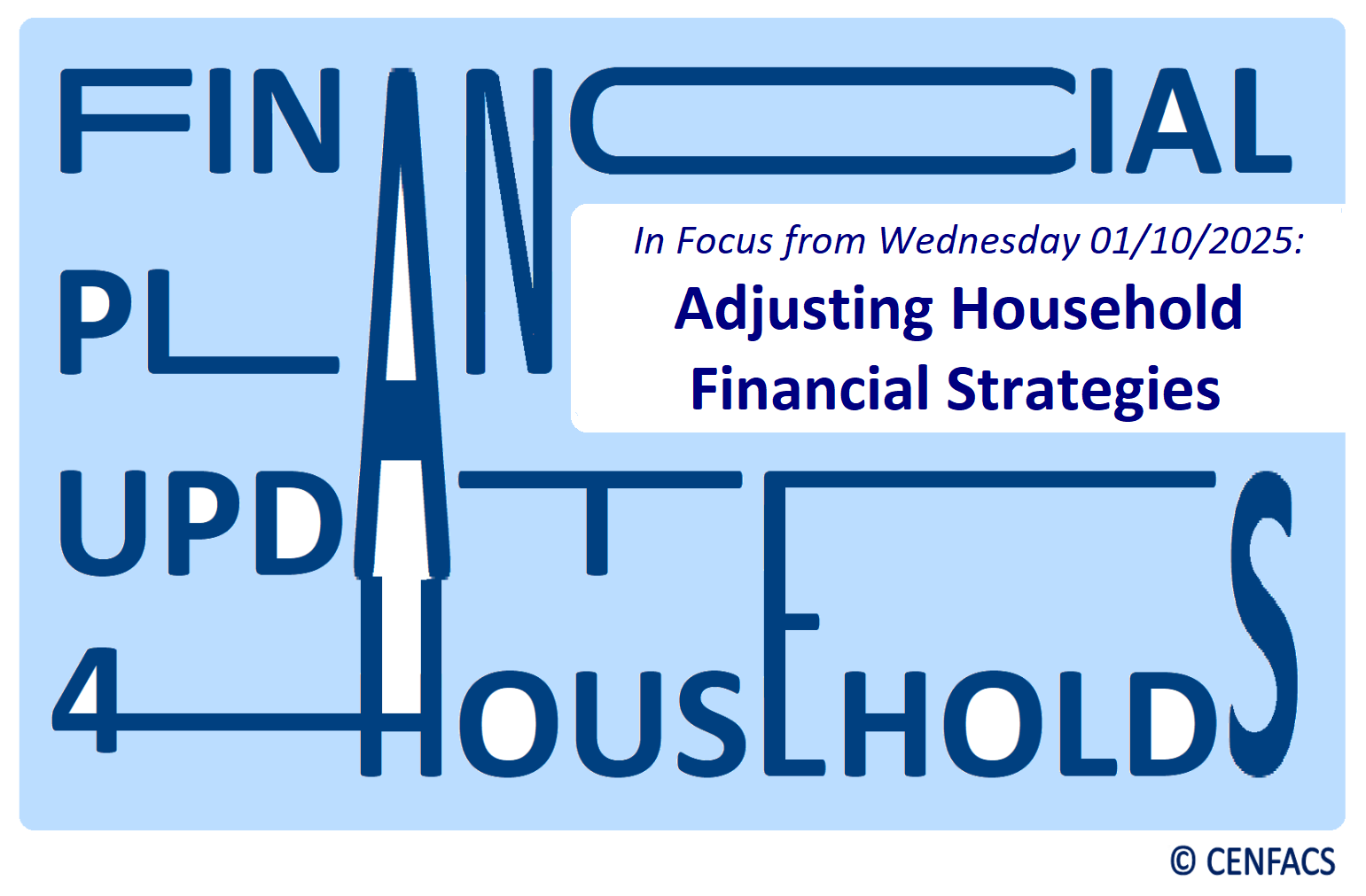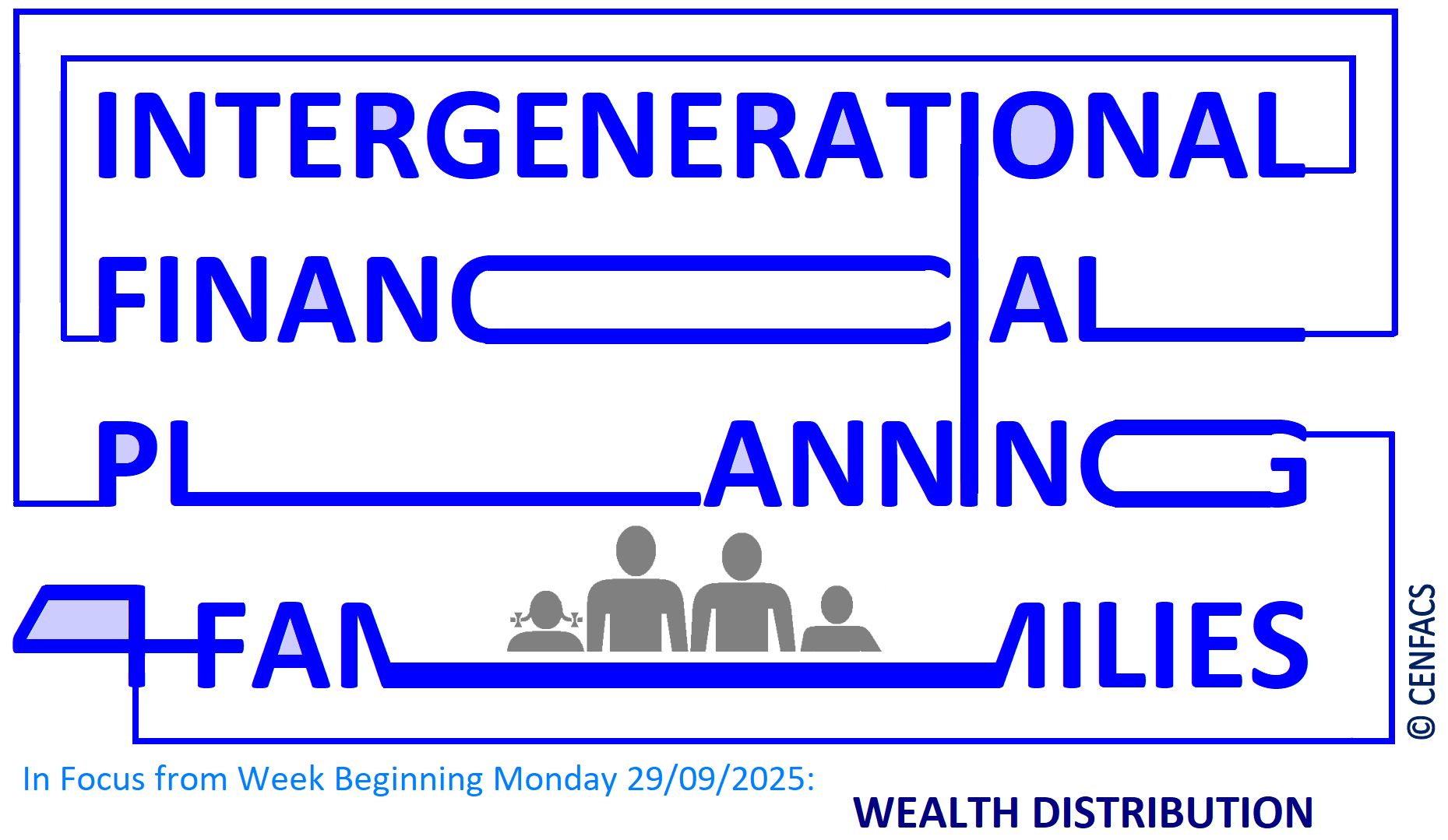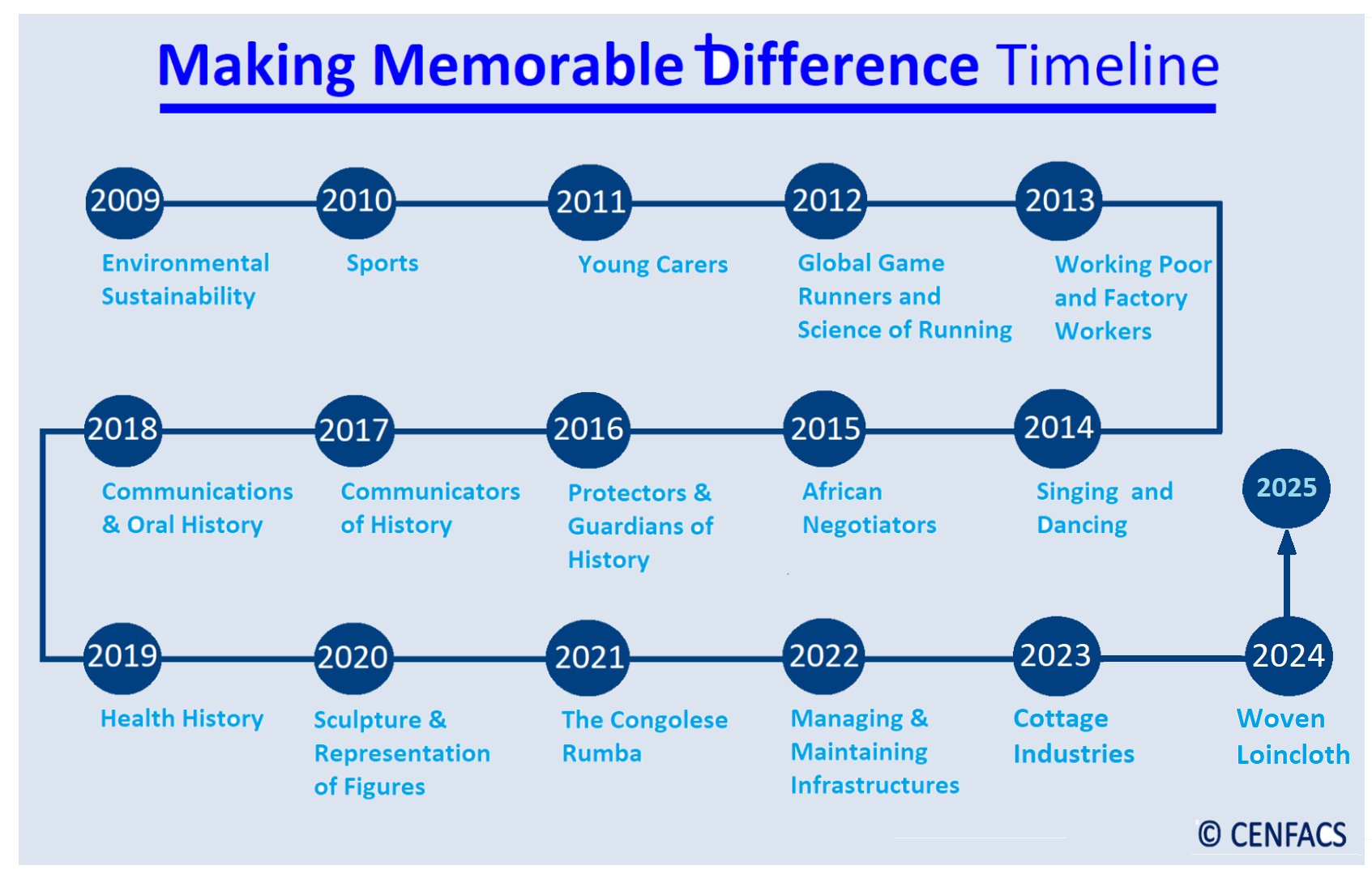Welcome to CENFACS’ Online Diary!
01 October 2025
Post No. 424
The Week’s Contents
• History Month with Making Memorable Positive Difference Project – In Focus: History of Africa’s Green Industry
• Activity/Task 10 of the Restoration (‘R’) Year and Project: Share the History of Restoration and Poverty Reduction Linked to It
• Campaign to End Poverty Induced by High Costs of Living through Long-term Actions – In Focus from 01/10/2025: Improve Productivity and Earning Potential
… And much more!
Key Messages
• History Month with Making Memorable Positive Difference Project – In Focus: History of Africa’s Green Industry
This year’s Making Memorable Positive Difference (MM+D), which is the 17th edition, will be about the History of Africa’s Green Industry.
Perhaps, to better introduce this 17th edition of MM+D, let us explain green industry. To clarify it, let us refer to what World Green Economy Council (1) argues about it, which is:
“Green industry means economies striving for a more sustainable pathway of growth, by undertaking green public investments and implementing public policy initiatives that encourage environmentally responsible private investments”.
Taking the same line of reasoning, ‘fpt-io.com’ (2) states that
“Green industry aims to decouple economic growth from environmental degradation. It involves resource efficiency, pollution prevention, sustainable product design, circular economy, and renewable energy integration”.
Knowing what green industry is, it is worth mentioning that the history of Africa’s green industry is marked by a transition from fossil-fuelled, extractive growth to a sustainable, green economy. This historical shift is driven by Africa’s resources, ingenuity and the desire of Africa to be among the major players in the global green economy. This is despite the nascent character of Africa’s formal ‘green industry’ heritage.
As part of MM+D 2025, we will remember the history of green industry in Africa and the key individuals who shaped Africa’s green industry. In particular, we shall reminisce key figures who represent a historical legacy of African innovators and activists in the ‘green industrialist’ space. We will also look back the relationship between Africa’s history of green industry and poverty reduction, although this relationship is complex and multifaceted.
This year, MM+D 2025 is in the Year of African Cultural Heritage (3). Because of that, during MM+D 2025 we shall re-examine the historical links between Africa’s culture and green industry, between Africa’s heritage and green industry. Africa’s culture is historically linked to the green industry through the emphasis on sustainable practices rooted in traditional knowledge on sustainable agriculture and resource management. Africa’s heritage is connected to the green industry through its abundant renewable energy sources and critical minerals.
MM+D 2025 will therefore provide opportunity to relearn about Africa’s green industry. In short, we shall undertake the following two tasks:
a) study the history of Africa’s green industry
b) assess the historical contribution of Africa’s green industry in reducing green poverty as well as the links of this industry with Africa’s culture and heritage.
For further information on this acknowledgement about the History of Africa’s Green Industry, please read under the Main Development section of this post.
• Activity/Task 10 of the Restoration (‘R’) Year and Project: Share the History of Restoration and Poverty Reduction Linked to It
Our Restoration (‘R’) Year and Project have progressed to Activity/Task 10, which is ‘Share the History of Restoration and Poverty Reduction Linked to It’. To undertake this task, one needs to know what we mean by sharing restoration history, efforts deployed to reduce poverty attached to restoration history, and ways in which they can support this activity/task.
• • What Is Sharing the History of Restoration?
It involves understanding its significance and impact on various aspects of life and society. The history of restoration is a period that has been studied and discussed for its unique characteristics and the changes it brought about.
This restoration study and discussion can touch many aspects of life, such as political changes, cultural revival, literary development, social and economic changes like in the UK. Since we are in the Year of African Cultural Heritage, one can think of sharing the history of restoration in the African context and relate it to poverty reduction. Let us illustrate it.
• • Example of Sharing Restoration History and Its Links with Poverty Reduction: Case of Africa
In the context of Africa’s History of Restoration, the sharing exercise can include many types of sharing like the following ones:
• • • Sharing the history of cultural heritage restoration
This could include the history of efforts to return cultural property, such as artefacts and sacred objects.
The link here with poverty reduction could be to heal and empower poor communities who were affected by historical dispossession.
• • • Sharing the history of restitution initiatives
This could be about the history of returned looted African treasures.
The link with poverty reduction could be to reclaim cultural identity and heritage as well as addressing historical injustices.
The two examples are just among the many ways of illustrating the sharing of restoration history.
• • Supporting This Activity/Task
Those who would like to proceed with this activity/task by themselves can go ahead. They can follow these steps:
plan the way they want to share restoration history, use a structured approach to guide the restoration process in this sharing, and use restoration techniques to guide people looking for restoration.
Those who would to be part of a working group helping in the realisation of this activity/task can let CENFACS know.
The above is what Activity/Task 10 of the Restoration (R) Year/Project is about. Those who would like to undertake it, they can go ahead.
For those who need some help before embarking on this activity/task, they can speak to CENFACS. To speak to CENFACS, they are required to plan in advance or prepare themselves regarding the issues they would like to raise.
For any other queries and enquiries about the ‘R‘ project and this year’s dedication, please contact CENFACS as well.
• Campaign to End Poverty Induced by High Costs of Living through Long-term Actions – In Focus from 01/10/2025: Improve Productivity and Earning Potential
Improve Productivity and Earning Potential is the first long-term campaign action of our Campaign to End Poverty Induced by High Costs of Living. To understand this action, it is better to clarify the meanings of productivity and earning capacity. This understanding will be in the context of employees/workers rather than from the perspective of businesses/employers.
• • Meaning of Productivity in the Context of Employees/Workers
According to ‘ibm.com’ (4),
“Employee productivity measures how efficiently and effectively a worker or a group of workers contribute to accomplishing organisational goals. It is a key performance indicator (KPI) that measures the output of work in relation to the inputs of time, effort and resource”.
As part of long-term campaign actions, this indicator can be improved in order to reduce or end poverty induced by high costs of living. However, one should not single out this indicator as the only strategy to reduce poverty. In other words, improving productivity needs to be within the overall strategy for ending poverty induced by high costs of living.
For instance, in the UK studies indicate that productivity growth has been a concern, with recent trends showing a decline in productivity over the past quarter-century, and the average annual change in the output per hour worked being significantly lower than historical levels.
Referring to productivity as output per hour worked, the Office National for Statistics (5) in the UK states that
“Output per hour worked was lower (negative 0.8%) in Quarter 2 of 2025 than in the same quarter a year ago. This is because hours worked increased more that Gross Value Added (2% and 1.1% respectively”.
Briefly speaking, if one wants to end poverty induced by high costs of living, then they need to improve employee productivity.
• • Meaning of Earning Capacity in the Context of Employees/Workers
The definition retained here comes from ‘invezz.com’ (6), which explains that
“Earning capacity refers to an individual’s potential or ability to generate income over a specific period, typically influenced by factors such as education, skills, experiences, market demand, and economic conditions”.
According to the Office for National Statistics (7),
“[In Great Britain,] Average Weekly Earnings were estimated at £727for total earnings and £680 for regular earnings in July 2025”.
One needs to consider both real and nominal earnings as well as earning capacity in order to have a true picture of earnings in the UK.
Earning potential and ability to generate income for poor people and those experiencing multiple socio-economic barriers can be very limited. Improving their earning capacity could mean undertaking various strategies including the removal of existing inequalities and disparities. Therefore, this long-term action will aim at tackling the spectrum of barriers and obstacles lying on the way of poor or low-income earners to generate enough income to make ends meet.
Because of the limitations that poor and low-income people have in terms of productivity and earning capacity, there is a need to develop or revisit strategies to help people improve their productivity and capacity to earn or generate income.
• • Strategies for Improving Productivity and Capacity to Earn or Generate Income
These strategies include the following elements:
σ Identification and leverage of personal strengths
σ Setting of clear goals and tracking of progress
σ Provision of training and the development of opportunities
σ Promotion of supportive work environment
σ Encouragement of time management and task prioritisation
Etc.
These elements can be incorporated in the long-term strategy to End Poverty Induced by High Costs of Living.
Those who will be interested in this first campaign action and would like to join it, they should not hesitate to contact CENFACS.
Those who have any enquiries and or queries about Campaign to End Poverty Induced by High Costs of Living through Long-term Actions, they can address them to CENFACS.
Extra Messages
• “A la une” (Autumn Leaves of Action for the Upkeep of the Nature) Campaign with Concentration on Critically Endangered Amphibian Species
• Financial Plan Updates for Households in 2025 – Third Update from Wednesday 01/10/2025: Adjusting Household Financial Strategies
• Intergenerational Financial Planning for Families – In Focus from Week Beginning Monday 29/09/2025: Wealth Distribution
• “A la une” (Autumn Leaves of Action for the Upkeep of the Nature) Campaign with Concentration on Critically Endangered Amphibian Species
This year, “A la une” – which takes Save Fauna, Flora and Funga advocacy to the next level of CENFACS‘ environmental communications and awareness raising – will be concentrated on Critically Endangered Amphibian Species. We shall focus on saving endangered amphibians through our new initiative called ‘MAMBILANGA’. What do we mean by endangered?
• • Meaning of Endangered
Endangered can be defined from the Oxford Dictionary of Environment and Conservation written by Chris Park (8) as
“A species that is in danger of *extinction if existing pressures on it (such as over-harvesting or habitat change) continue, and which is therefore likely to disappear if it is not offered adequate protection” (p. 147)
As said above, we shall focus on saving endangered amphibians through our new initiative called ‘MAMBILANGA’.
• • ‘MAMBILANGA’ (Mind Amphibians for Maintaining the Balance of Insects in the Lives of Aquatics and Nutrients, and for Guarding Agriculture) as a Focus of Our ‘A la Une’ Campaign
MAMBILANGA is a new advocacy project planned by CENFACS to help protect critically endangered amphibian species and keep them up in their natural habitat in Africa. Amphibians like Pickersgill’s Reed Frog (Hyperolius pickersgill), Whitebelly Egg Frog (Leptodactylodon albiventris), and Western Nimba Toad are critically endangered. Likewise, Western Leopard Toad, Goliath Frog, Big-eyed Forest Tree Frog, and Perret’s Night Frog are endangered species.
The ‘MAMBILANGA ’ project, which has already kicked off, will help us to advocate for a safe life for amphibian species.
In the coming weeks, we are embarking on a campaign to help save critically threatened amphibians by extinction in Africa. It is a campaign to help save the above-mentioned amphibian species and similar species threated by extinction.
This Autumn campaign to help save amphibians will be featured by a number of notes to be written to make up the theme of the campaign. There will five notes which will be related to five of the above-mentioned amphibians.
They are endangered species. The ‘MAMBILANGA’ project will help to advocate for a safe life for these amphibians.
To support “A la une” campaign and “MAMBILANGA” project, please contact CENFACS.
• Financial Plan Updates for Households in 2025 – Third Update from Wednesday 01/10/2025: Adjusting Household Financial Strategies
Household financial strategies can be adjusted in the light of new events and circumstances. Before looking at these adjustments, let us briefly highlight the meaning of financial strategies.
• • What Are Financial Strategies?
The website ‘wallstreemojo.com’ (9) explains that
“Financial strategies refer to the comprehensive plans and approaches that individuals, businesses, or organisations adopt to mange their financial resources effectively. These strategies encompass a wide range of activities, including budgeting, investment planning, debt management, risk mitigation, and overall financial decision-making. The aim here is to achieve financial stability, growth, and sustainability”.
Knowing what financial strategies are, it is possible to adjust these strategies according to life circumstances and events.
• • Adjusting Household Financial Strategies
To adjust their financial strategies, households can
σ Create a realistic budget (that includes all income sources and that do not exceed spending level)
σ Prioritise needs over wants (necessities over desires or mindful consumption over mindless one)
σ Track and monitor their spending (by using apps or spreadsheets to keep a close eye on their spending habits and identify areas of improvement)
σ Design their budget (by utilising budgeting tools like budget planner)
σ Develop and put their mindful spending plan into action.
The above-mentioned strategies or steps can help households to better manage their finances and achieve their financial goals.
• • Working with CENFACS Community Members on Adjusting Household Financial Strategies via a Weekend Homework for Households
As a way of supporting this week’s topic relating to Adjusting Household Financial Strategies, we are asking to those who can to conduct this weekend homework activity:
Prioritise your needs over wants.
Those who may have some questions about this activity, they should not hesitate to contact CENFACS.
Those who may be interested in the Adjusting Household Financial Strategies can contact CENFACS for further details.
If you need support with your Financial Plan Updates or for us to look at your Financial Plan, please do not hesitate to communicate with CENFACS.
• Intergenerational Financial Planning for Families – In Focus from Week Beginning Monday 29/09/2025: Wealth Distribution
To distribute wealth to family members requires careful planning, communication, and consideration of tax implications to ensure fairness and long-term financial health. Before considering these key aspects of wealth distribution, let us briefly define wealth distribution in the context of a family.
• • What Is Wealth Distribution in the Context of a Family?
It refers to the way in which the total wealth of a family is divided among its members. It encompasses the disparities in the ownership, control, and accumulation of assets, such as property investments, and other financial resources, across different segments of the family.
The Resolution Foundation (10) notes that
“It involves the strategic allocation of assets and wealth among family members to ensure effective wealth transfer and legacy planning. This process is crucial for maintaining family values, supporting philanthropic endeavours, and ensuring that assets are available when needed for transfers, tax payments, or legacy funding”.
Those members of the families making the CENFACS Community can be aware of these explanations so that when the time comes to transfer their wealth, they act in the proper manner and according to the laws/rules relating to wealth distribution. If they are not sure there are experts in wealth distribution who can advise or guide them accordingly.
• • Key Considerations for Wealth Distribution
They summarily include the following ones:
σ Educate your family members about financial management before wealth distribution occurs
σ Determine the amount to distribute by working with a financial planner
σ Plan the timing of your wealth distribution
σ Identify beneficiaries by deciding who will benefit from your wealth
σ Use trusts and wills to help you manage the wealth distribution process
σ Communicate openly with your family members about your wealth distribution plan
σ Consider staggered distribution for younger beneficiaries
σ Consult professionals in wealth distribution.
These above-mentioned elements will help anyone who follows them to create an effective and thoughtful wealth distribution plan that supports their family’s financial well-being and keeps legacy for future generations of their family.
• • Working with CENFACS Community Members on Wealth Distribution via a Weekend Homework for Families
As a way of supporting this week’s topic relating to Wealth Distribution, we are asking to those who can to conduct this weekend homework activity:
Discuss financial principles and values of your family in terms of financial management.
Those who may have some questions about this activity, they should not hesitate to contact CENFACS.
Those who would like to know more about Wealth Distribution and to work with CENFACS, they can contact us.
Similarly, those who may be interested in Intergenerational Financial Planning or in discussing any matter relating to the topic of Wealth Distribution, they should feel free to contact CENFACS. Equally, those who would like to tackle intergenerational poverty can communicate with CENFACS.
Message in English-French (Message en Anglais-Français)
• CENFACS’ be.Africa Forum E-discusses African Law Firms and Their Impact on Poverty Reduction in Africa
African law firms (both for- and not-for-profit ones) support poverty reduction efforts by advising on working environment reforms that improve firms performance, such as simplified registration and tax processes. They also engage in public interest and pro bono work, like challenging inadequate access to water or representing human rights, which can lift people out of poverty. Additionally, by facilitating foreign direct investment and navigating complex regulatory landscapes, they contribute to job creation and economic development, which are crucial for poverty reduction.
These firms contribute to poverty reduction in Africa. They can even do more for poverty reduction. Our e-discussion is on their impact on poverty reduction and how they can increase and improve their impact, in particular in some places in Africa where poor people do not have a voice to reclaim their human, economic and sustainable rights.
For instance, in the areas of the impact from environmental events (like flooding), how these firms can assist the victims of flooding to claim their rights or compensations as a result of these events is one the e-discussion topics.
Those who may be interested in this discussion can join our poverty reduction pundits and/or contribute by contacting CENFACS’ be.Africa Forum, which is a forum for discussion on poverty reduction and sustainable development issues in Africa and which acts on behalf of its members by making proposals or ideas for actions for a better Africa.
To contact CENFACS about this discussion, please use our usual contact address on this website.
• Le Forum ‘Une Afrique Meilleure’ de CENFACS discute en ligne des Cabinets d’Avocat Africains et Leur Impact sur la Réduction de la Pauvreté en Africa
Les cabinets d’avocats africains (qu’ils soient à but lucratif ou non lucratif) soutiennent les efforts de réduction de la pauvreté en conseillant sur des réformes de l’environnement de travail qui améliorent la performance des entreprises, telles que la simplification des processus d’enregistrement et fiscaux. Ils s’engagent également dans des travaux d’intérêt public et des activités pro bono, comme contester l’accès insuffisant à l’eau ou défendre les droits humains, ce qui peut aider à sortir les gens de la pauvreté. De plus, en facilitant les investissements directs étrangers et en naviguant dans des environnements réglementaires complexes, ils contribuent à la création d’emplois et au développement économique, essentiels pour la réduction de la pauvreté.
Ces entreprises contribuent à la réduction de la pauvreté en Afrique. Elles peuvent même faire davantage pour réduire la pauvreté. Notre e-discussion porte sur leur impact sur la réduction de la pauvreté et sur la manière dont elles peuvent accroître et améliorer leur impact, en particulier dans certaines régions d’Afrique où les populations pauvres n’ont pas de voix pour revendiquer leurs droits humains, économiques et durables.
Par exemple, dans le domaine de l’impact des événements environnementaux (comme les inondations), comment ces entreprises peuvent aider les victimes des inondations à faire valoir leurs droits ou à obtenir des compensations à la suite de ces événements est parmi les sujets de notre discussion en ligne.
Ceux ou celles qui pourraient être intéressé(e)s par cette discussion peuvent se joindre à nos experts en réduction de la pauvreté et/ou contribuer en contactant le ‘me.Afrique’ du CENFACS (ou le Forum ‘Une Afrique Meilleure’ de CENFACS), qui est un forum de discussion sur les questions de réduction de la pauvreté et de développement durable en Afrique et qui agit au nom de ses membres en faisant des propositions ou des idées d’actions pour une Afrique meilleure.
Pour contacter le CENFACS au sujet de cette discussion, veuillez utiliser nos coordonnées habituelles sur ce site Web.
Main Development
• History Month with Making Memorable Positive Difference Project – In Focus: History of Africa’s Green Industry
The following items make up the contents of this year’s focus of Making Memorable Positive Difference Project:
∝ What Is Making Memorable Positive Difference Project (MM+D)?
∝ What Is This Year’s MM+D?
∝ MM+D Days
∝ MM+D Timeline
Let us look at each of these contents.
• • What Is MM+D?
MM+D is
∝ a two-day event of Awareness, Thought and Recognition set up by CENFACS in 2009 to celebrate the Black History Month in our own way and feeling while preserving the tradition linked to this remembrance and standing on the shoulders of similar celebrations
∝ a history project of collective memory about works carried out, heritage and legacies left by Africans
∝ all about collectively telling, acknowledging, studying and learning that everyday Africans wherever they are (in Africa) or elsewhere (in the UK-Croydon and the world) are striving to improve the quality of their lives and of others. Through their historically valuable works, they are making memorable positive difference and the world a better place for everybody, including the generations to come.
∝ a celebration of African Abilities, Talents, Skills, Techniques, Technologies, Gifts and Legacies to Africa and the world.
• • What Is This Year’s MM+D?
This year’s dedicated two days (27 and 28 October 2025) are days of historical study, analysis, skill recognition and celebration of the legacies left by Africans in Green Industry in Africa.
As above-mentioned in the Key Messages, the history of Africa’s green industry is marked by a transition from fossil-fuelled, extractive growth to a sustainable, green economy. This historical shift is driven by Africa’s resources, ingenuity and the desire of Africa to be among the major players in the global green economy. This is despite the nascent character of Africa’s formal ‘green industry’ heritage.
This year’s MM+D is about celebrating this history. It is a celebration of …
√ African green industry skills related to renewable energy technologies (like solar, wind, and hydropower), sustainable agriculture, organic farming and circular economy principles, etc.
√ Traditional practices and lifestyles as historical roots of green makings in Africa
√ The Green Revolution in the 1960s and 1970s which introduced high-yielding agricultural technologies
√ African communities relying on traditional sustainable ways of life and livelihoods
√ Critical minerals crucial for today’s green technologies
√ Africa’s natural capital and assets which historically provide ecosystem services
√ The reduction of green poverty
√ Agro-industrial potential and assets.
So, this year’s MM+D is a celebration of African Abilities, Practices, Talents, Skills, Techniques, Technologies, Gifts and Legacies to Africa and the world in terms of Green Industry.
• • MM+D Days
There will be Two Days of the History of Africa’s Green Industry as follows:
∝ One day of identifying and profiling historical African figures (including green industry activists and advocates) in Africa’s green industrial sector
∝ One day of assessing the historical role of green industry in reducing green poverty and in enhancing sustainable industrial development in Africa.
Let us summarise the contents of each day’s work.
• • • Day of Heritage/Patrimony/Industrialists/Activists/Advocates (27 October 2025): History of Those Who Shaped the Green Industry in Africa
On the first day of our MM+D, which is the Heritage and Patrimony Day, we shall remember those talented and skilful African industrialists, activists, and advocates of green industry for their admirable green and sustainable skills and techniques, which were passed on to other generations. It is the day of learning a brief outline or sketch in terms of their profiles and their historical green and sustainable industrial development work.
Through the study of their profiles and green industrial work, it will be possible to know the kind of role they played or did not play in the development of green industry in Africa. They are part of Africa’s heritage and patrimony as they represent Africa’s historic green industry traditions and Africa’s wealth, that transcends many eras and was passed on to other generations.
Since we are in 2025 as the Year of African Cultural and Heritage, Heritage and Patrimony Day of MM+D will also be about looking at the links between Africa’s culture and the green industry, between Africa’s heritage and the green industry.
The links between Africa’s culture and the green industry will be about emphasizing sustainable practices rooted in traditional knowledge, like sustainable agriculture and resource management, and the adoption of new technologies that align with cultural values of community and resilience in Africa. It is also about how green policies were fitted into Africa’s culture; policies that leverage Africa’s vast natural and human resources to develop green value chains in sectors like renewable energy, green construction, and agriculture, aiming for both climate action and economic development to address challenges such as poverty and food security.
The connections between Africa’s heritage and the green industry will consist of acknowledging Africa’s rich heritage which is associated with the green industry through its abundant renewable energy sources and critical minerals, which are essential for the global clean energy transition, as well as through the potential to develop local, sustainable economies. This heritage also includes traditional knowledge of land and resource management which can inform sustainable practices and community-led conservation efforts, fostering both ecological health and economic development.
• • • Legacies and Gifts Day (28 October 2025): The Historical Role of Green Industry in Reducing Green Poverty and in Enhancing Sustainable Industrial Development in Africa
On the Legacies and Gifts Day of MM+D, we shall learn what was handed on to the current generations in terms of knowledge and techniques to reduce green poverty and enhance sustainable industrial development in Africa by the industrialists, green activists and advocates of the past. We shall as well recollect in our memory what these past green industry players gave to today’s green economy and industrial development in Africa. In other words, we shall study the legacies and gifts of green industry in reducing green poverty and creating green wealth in Africa.
Still on the Legacies and Gifts Day of MM+D, we shall discuss the legacies of Africa’s growing green industry in terms of sustainable industrial development. Its legacies include a shift in the global narrative of Africa, increased economic opportunities in green sectors, enhanced energy security, and the potential for a sustainable industrial development that leverages vast renewable resources. We shall as well talk about the gifts that African green industry offers. In particular, emphasis will be put on the gifts of sustainable growth, green poverty reduction, and job creation by focusing on renewable energy, sustainable agriculture, green infrastructure, and eco-tourism; leveraging Africa’s natural resources to achieve economic development without environmental degradation..
The above is this year’s MM+D theme. To engage with this theme and or support this project, please contact CENFACS on this site.
Because we are talking about history, let us remember the history of CENFACS‘ MM+D through timeline.
• • Making Memorable Positive Difference Timeline
MM+D has a history and timeline. The following is the timeline of MM+D since its inception.
2009: CENFACS recognised environmental sustainability.
2010: We acknowledged and honoured sports contributions and history in relieving collective poverty and improving community lives beyond fitness and beyond individualistic achievements.
2011: We recollected, remembered and revered caregiving talents and legacies of young carers in enhancing human development (their own development and other people’s development) by reducing the burden of poverty.
2012: We dedicated our historical recognition to Africa’s Global Game Runners and the Science of Running.
2013: Our two days were about the Memorable Positive Difference Made and brought by Working Poor (Miners & Factory Workers) in relieving poverty. We consecrated them to the historical study of The Role of Working Poor Miners and Factory Workers of Natural Resources and Extractive Industries in the Poverty Relief in Africa since the Berlin Conference (1884-5).
2014: We celebrated the place of the African Music and Dance in the pre– and post-colonial eras, the late 1950s and the early 1960s. This celebration focused on the African History of Singing and Dancing and their Impacts on Liberation and Freedoms.
2015: Making Memorable Positive Difference focused on African Negotiators of the History.
2016: We remembered the Protectors and Guardians of the African History and Heritage.
2017: We acknowledged the Communicators of the African History
2018: We learnt about African Communications and Oral History
2019: We searched on the African Health History
2020: We celebrated African Sculpture and Representation of African Historical Figures of the Pre-independence Era (i.e. Period before the 1960s)
2021: We recognised and celebrated of the legacies left by Africans in dance, particularly the Congolese Rumba
2022: We acknowledged the gifts left by Africans in Infrastructures to Reduce Poverty, particularly the Management and Maintenance of These Infrastructures.
2023: We remembered Cottage Industries in Africa or Household-based Industries in their capacity and capability of lifting people out of poverty.
2024: We learnt about the History of African Woven Loincloth and how woven loincloth lifted people out of clothing poverty, although at that time weavers of loincloth might not have thought about reducing clothing poverty.
For further details about these past MM+D events, please contact CENFACS.
_________
• References
(1) https://wgeco.org/green-industry/ (accessed in September 2025)
(2) https://fpt-io.com/en/insights/green-industry-the-blueprint-for-sustainable-economic-growth/ (accessible in September 2025)
(3) https://aedic.eu/human-rights/2025-the-year-of-african-cultural-heritage-restitution-and-global-collaboration/ (accessed in September 2025)
(4) https://www.ibm.com/think/topics/employee-productivity (accessed in September 2025)
(5) https://www.ons.gov.uk/employmentandlabourmarket/peopleinwork/labourproductivityintroduction/apriltojune2025andjanuarytomarch2025#:~text=output…(accessed in September 2025)
(6) https://invezz.com/definitions/earning-capacity/ (accessed in September 2025)
(7) https://www.ons.gov.uk/employmentandlabourmarket/peopleinwork/employmentandemployeetypes/bulletins/averageyearningsingreatbritain/september2025#:~:text=… (accessed in September 2025)
(8) Park, C., (2011), Oxford Dictionary of Environment and Conservation, Oxford University Press, Oxford & New York
(9) https://www.wallstreemojo.com/financial-strategies/ (accessed in September 2025)
(10) https://www.resolutionfoundation.org/app/uploads/2020/12/The-UKs-Wealth-distribution.pdf (accessed in September 2025)
_________
• Help CENFACS Keep the Poverty Relief Work Going This Year
We do our work on a very small budget and on a voluntary basis. Making a donation will show us you value our work and support CENFACS’ work, which is currently offered as a free service.
One could also consider a recurring donation to CENFACS in the future.
Additionally, we would like to inform you that planned gifting is always an option for giving at CENFACS. Likewise, CENFACS accepts matching gifts from companies running a gift-matching programme.
Donate to support CENFACS!
FOR ONLY £1, YOU CAN SUPPORT CENFACS AND CENFACS’ NOBLE AND BEAUTIFUL CAUSES OF POVERTY REDUCTION.
JUST GO TO: Support Causes – (cenfacs.org.uk)
Thank you for visiting CENFACS website and reading this post.
Thank you as well to those who made or make comments about our weekly posts.
We look forward to receiving your regular visits and continuing support until the end of 2025 and beyond.
With many thanks.


